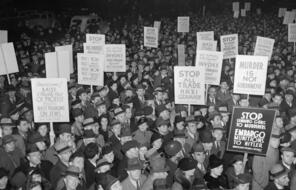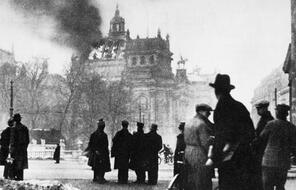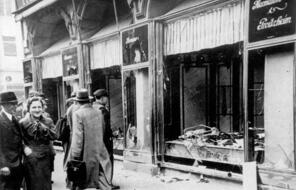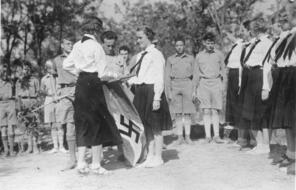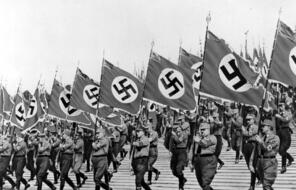The Holocaust in Lithuania
Subject
- History
Language
English — USUpdated
In 1939, the Soviet Union and Germany established what is known as the Molotov-Ribbentrop Pact. The Germans marched into western and central Poland, while the Soviet Union took control of Belarus, Eastern Poland, Estonia, Latvia, and Lithuania, establishing its military headquarters in Vilna. In June 1940, the Soviet Red Army marched into Lithuania and fully annexed it to the Soviet Union. In the days before the diplomats had to leave Vilna, the Japanese Consul Sempo Sugihara and the Dutch Consul cooperated with local Jews and issued visas that allowed for the escape of the Mir Yeshiva rabbis and students to Shanghai.
Soviet communism brought traumatic changes to the region. As the Soviets took control of the country, they began a campaign of terror, targeting people declared to be enemies of communism. Politicians, intellectuals, and community leaders were purged and executed in an atmosphere of lawlessness and extreme violence. The Soviets also began to nationalize farms, factories, and mines, transferring both people and equipment inland as part of their economic strategy. The Soviets sent tens of thousands of Lithuanians to Siberia for internment in labor camps (gulags). The death rate among the deported—7,000 of them were Jews—was extremely high. Still, though these Jews faced harsh conditions that caused many to die, they did not face systematic murder. They were taken away not because they were Jews but because they were capitalists. Little could they imagine that they were the fortunate ones, for more than 90% of those who were not deported by the Soviets were murdered by the Germans and their collaborators.
The Sovietization of the Lithuanian economy affected Jews profoundly, and many of them lost their livelihood, property, and businesses. Communist ideology was against religion, all religions. So religious Jews were persecuted and synagogues were closed, as were religious Christians and churches. Communism was against capitalism, so Jewish merchants lost their stores and factory owners their factories. However, many professions previously closed to Jews were now open because the Soviets lifted Lithuania’s antisemitic regulations. For example, Jews were no longer prevented from employment in local and state government. Jews, therefore, benefited to some extent from the Soviet occupation. Although some Jews supported a version of socialism or communism, the majority did not. This fact did not prevent Lithuanian nationalists and others from claiming that Jews were collaborating with the Soviet occupiers. Others openly accepted the claims of Nazi antisemitic propaganda, which argued that Jews controlled the Soviet Union and were conspiring to take over the world.
Although Jews did not support communism, most preferred the Soviets to the Germans, whose intentions had become increasingly alarming. As Jews became more visible in the Soviet government, many Lithuanians (and a minority of ethnic Germans, Poles, and Ukrainians) found Jewish-Soviet collaboration to be a symbol of betrayal. They conveniently overlooked the far more extensive collaboration of Lithuanian nationals with Soviet authorities. These factors, plus the high level of violence and lawlessness happening under Soviet rule, set the stage for a brutal display of hostility and vengeance toward the Jews.
According to scholars at the United States Holocaust Memorial Museum:
The Lithuanians carried out violent riots against the Jews both shortly before and immediately after the arrival of German forces. In June and July 1941, detachments of German Einsatzgruppen (mobile killing units), together with Lithuanian auxiliaries, began murdering the Jews of Lithuania. By the end of August 1941, most Jews in rural Lithuania had been shot. By November 1941, the Germans also massacred most of the Jews who had been concentrated in ghettos in the larger cities. The surviving 40,000 Jews were concentrated in the Vilna, Kovno, Siauliai, and Svencionys ghettos, and in various labor camps in Lithuania. Living conditions were miserable, with severe food shortages, outbreaks of disease, and overcrowding.
How to Cite This Reading
Facing History & Ourselves, “The Holocaust in Lithuania”, last updated May 13, 2016.

